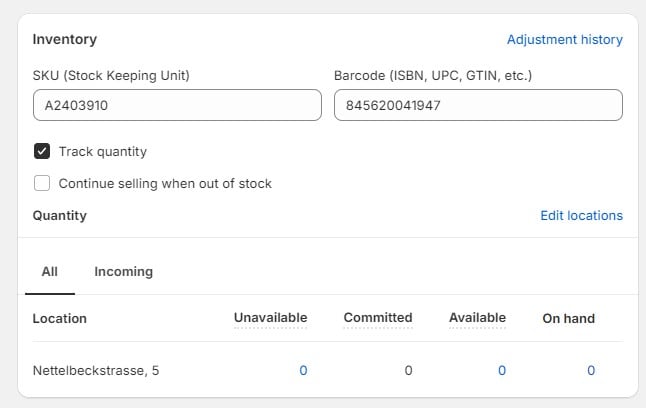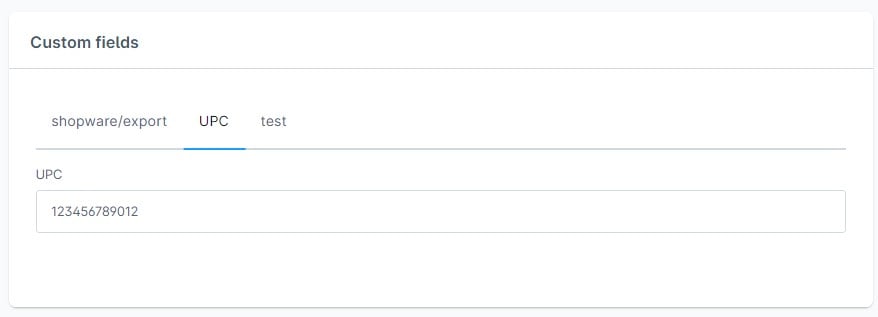SKU vs UPC: Key Differences in Product Identification for E-Commerce Platforms like Magento, Shopify, and Shopware

In the world of retail and e-commerce, efficient inventory management is essential. Two key tools that businesses use to organize, track, and sell products are SKUs (Stock Keeping Units) and UPCs (Universal Product Codes). While they may seem similar at first glance, SKUs and UPCs serve distinct purposes and are critical for different stages of the product management process. In this guide, we’ll dive into what each identifier does, compare their differences, and explore why understanding SKU vs UPC is crucial for businesses — especially those selling across multiple platforms. Check our eCommerce glossary of terms to discover other useful insights.

Table of contents
What Are SKUs?
SKUs are internal identifiers that businesses create to manage their inventory effectively. They help organize products by distinguishing key details such as size, color, brand, and style.
Unlike UPCs, which are universal, SKUs are custom-built by companies to suit their specific product lines and operational needs. This allows businesses to categorize their stock in a way that makes the most sense for their operations.
For instance, a clothing retailer may use SKUs like SHRT-BLCK-S-GLDN-001 to indicate a small, black shirt by Gildan of a specific model.

The beauty of SKUs is that they provide an internal shorthand that employees and systems can easily understand to track stock, restock items, and manage product variations.
The SKU format is custom and may depend on the requirements of your e-commerce platform or inventory management system.
What Are UPCs?
While SKUs are internal to a business, UPCs are standardized codes used worldwide to identify products. A UPC is a 12-digit number assigned to a product and is the same across all retailers and sales platforms. GS1, the global standards organization responsible for maintaining UPCs, manages these codes externally.
UPCs are everywhere, from the grocery store to your online checkout. They ensure that products are recognized universally.
For example, a box of Pringles Paprika Flavored Potato Chips will have the same UPC whether it’s sold at a local supermarket or on an international e-commerce site.

Thus, UPCs are crucial for sales transactions, allowing products to be scanned at the register, updating stock levels, and providing uniformity across various markets.
UPC Format
The UPC format consists of a 12-digit numeric code that is divided into several parts:
- First 6 digits (Company Prefix): Assigned by GS1, this part identifies the manufacturer or company that produces the product.
- Next 5 digits (Item Reference Number): This portion is chosen by the manufacturer and identifies the specific product or item. It differentiates products under the same brand.
- Last digit (Check Digit): The final digit is a check digit used for error detection. It is calculated based on the previous 11 digits to ensure the barcode is scanned accurately.
SKU vs UPC: Key Differences
Now that we understand what each identifier does, let’s compare SKUs and UPCs side by side.
| Identifier | What It Tracks | Who Creates It | Where It’s Used | Example |
| SKU (Stock Keeping Unit) | Internal product variations (size, color, etc.) | Created by the company | Internal inventory management | SHRT-BLCK-S-GLDN-001 |
| UPC (Universal Product Code) | Standardized product identifier | Created by GS1 (global organization) | External sales and checkout systems | 012345678905 (Product barcode at checkout) |
- SKUs are unique to the business and are primarily used internally to track stock, manage warehouse operations, and distinguish between product variations. They offer businesses the flexibility to organize their inventory however they see fit.
- UPCs, on the other hand, are universal and used globally to identify products. They’re the key to ensuring that any item scanned at checkout or sold on a platform like Amazon is recognized, priced, and categorized correctly.
SKU vs UPC in Major E-Commerce Platforms: Magento, Shopify, and Shopware
Understanding the difference between SKUs and UPCs is crucial for any e-commerce business, especially if selling on multiple platforms. SKUs help you manage your internal inventory efficiently, while UPCs ensure your products are recognized across all sales channels, whether it’s your website, Amazon, or a physical store.
For instance, if you’re selling a pair of shoes on your website and Amazon, you’ll use an SKU to organize your stock internally. However, you’ll need the UPC to ensure that Amazon recognizes the product and lists it correctly. Without UPCs, you would have no way to sell on major online platforms, as they rely on these standardized codes to ensure consistency across listings.
While platforms like Magento, Shopify, and Shopware similarly handle inventory, each offers unique features for working with SKUs and UPCs, helping businesses track stock, streamline operations, and sell across multiple channels.
Let’s compare how SKUs and UPCs are implemented on these major platforms and explore the opportunities each one provides.
Magento: Advanced Inventory Control
Magento, known for its customization capabilities, provides extensive support for SKUs as a core part of its inventory management system. By default, every product created in Magento requires an SKU, making it the primary tool for identifying and tracking products. Magento also allows you to manage multiple stock locations and warehouses using SKUs, which is particularly useful for larger businesses with complex logistics.

You can use attributes – color, size, material, etc. – to design SKUs that make sense for your product catalog. Additionally, Magento’s multi-channel integration lets you sync SKUs across various platforms, so your internal inventory stays up to date whether you’re selling in-store, online, or through third-party channels like Amazon.
Magento supports UPCs as an optional product attribute, which is particularly useful for businesses that sell globally or on external platforms like Amazon or eBay. To add a UPC field for all products, similar to the SKU field in Magento, follow these steps:
- Go to the Magento Admin panel and navigate to Stores > Attributes.
- You will see two important sections:
- Product
- Attribute Set
- In the Product section, create a new attribute called UPC.

- Next, go to the Attribute Set section. Here, for each attribute set you want to modify, move the newly created UPC attribute from the “Unassigned Attributes” group to the appropriate group where you want it to appear.

This ensures the UPC field is displayed alongside other product information in your chosen attribute groups.

Shopify: Simple and Streamlined
In Shopify, SKUs are also mandatory for all products, making it easy for businesses to manage their inventory right from the start. Shopify keeps things simple with SKUs, allowing businesses to assign them as they see fit, without requiring any complicated setup.
Shopify’s inventory management tools let businesses use SKUs to organize products efficiently. Shopify is particularly well-suited for small to mid-sized businesses that need a straightforward way to track product variations. Shopify’s app ecosystem also offers a variety of plugins that extend SKU functionality, from creating bulk SKUs to automating stock management across multiple sales channels.
Unlike Magento, Shopify by default provides a dedicated field for UPCs under the product details page. You don’t need to create anything manually.

This is essential for businesses looking to expand their sales to platforms that require UPCs, like Google Shopping or Amazon. UPCs are seamlessly integrated with Shopify’s barcode scanner apps, allowing businesses to use UPCs for fast, accurate product management during fulfillment and checkout.
Shopware: Customizable for Scale
In Shopware 6, the platform primarily uses a product number field to identify and manage products, rather than traditional SKUs. The product number serves the same purpose as an SKU, acting as a unique identifier for each product in your catalog.
However, you can still manage and structure these product numbers flexibly, and if needed, UPCs can be added as custom attributes.
In Shopware 6, you can create custom attributes (also known as custom fields) to add additional information to your products, such as SKUs or UPCs. This allows you to enhance the default product data with fields specific to your business needs. Here’s how you can create and use custom attributes in Shopware 6:
- Navigate to Custom Fields. Go to the Shopware 6 Admin panel. In the sidebar, navigate to Settings > Custom Fields under the System section.
- Create a New Custom Field Set. Click on the Create New Custom Field Set button. A pop-up window will appear. Here, give your new custom field set a meaningful name (e.g., “UPC”) and select the entities where you want the custom fields to appear. In this case, choose Products. You can also define a technical name (used internally) and assign a position to determine where the custom fields will display.
- Add Custom Fields (Attributes). After creating the set, click on Add Custom Field to create individual attributes. Define the following for each field:
Label: The visible name for the field – UPC.
Technical Name: The system name used in the backend – upc_code.
Field Type: Select the appropriate type, such as Text Field.
Validation: Choose any validation rules (optional) like ensuring the field is required or unique.

- Save and Assign to Products. Once you’ve added your custom fields, save the field set. Your new custom attributes will now be available when you create or edit products.
- Assign the Custom Field to Product Details. Go to Catalog > Products and open any product to see the new custom fields available under the “Custom Fields” section of the Specifications tab. You can now enter values (like UPCs) for each product.

Comparing SKU vs UPC Implementation Across Platforms
| Platform | SKU Implementation | UPC Support |
| Magento | Mandatory SKU for all products; customizable based on product variations and categories | UPC fields can be added manually via custom attributes |
| Shopify | Mandatory SKU for inventory management; simple setup for small to mid-sized businesses | UPCs are available by default |
| Shopware | Uses product numbers instead. SKU fields can be added manually via custom attributes | UPC fields can be added manually via custom attributes |
Why Understanding SKU vs UPC on These Platforms Is Important
For businesses operating on e-commerce platforms like Magento, Shopify, or Shopware, knowing the difference between SKUs and UPCs is vital for smooth operations. SKUs, being a custom story unique for each store, allow for internal inventory organization, making it easier to manage stock and product variations. On the other hand, UPCs – GS1-maintained external numbers – are essential for businesses that sell on multiple platforms or ship internationally, as they ensure that products are universally recognized.
Choosing the right platform and understanding how each handles SKUs and UPCs can significantly improve inventory control, boost efficiency, and help expand your business into global markets. Whether you need advanced SKU management in Magento, simple tracking in Shopify, or scalable custom options in Shopware, the key is tailoring your approach to your business’s unique needs.
Conclusion
In the SKU vs UPC debate, the key takeaway is that both identifiers are essential, but they serve different purposes. SKUs give you the flexibility to track product variations and manage inventory internally, while UPCs are critical for selling products globally and ensuring they are recognized uniformly across different platforms.
For any e-commerce business, mastering the use of both SKUs and UPCs can streamline operations, prevent inventory mix-ups, and improve the efficiency of selling across multiple platforms. So, whether you’re organizing your warehouse or listing products on Amazon, understanding SKU vs UPC will make managing your inventory a breeze!









